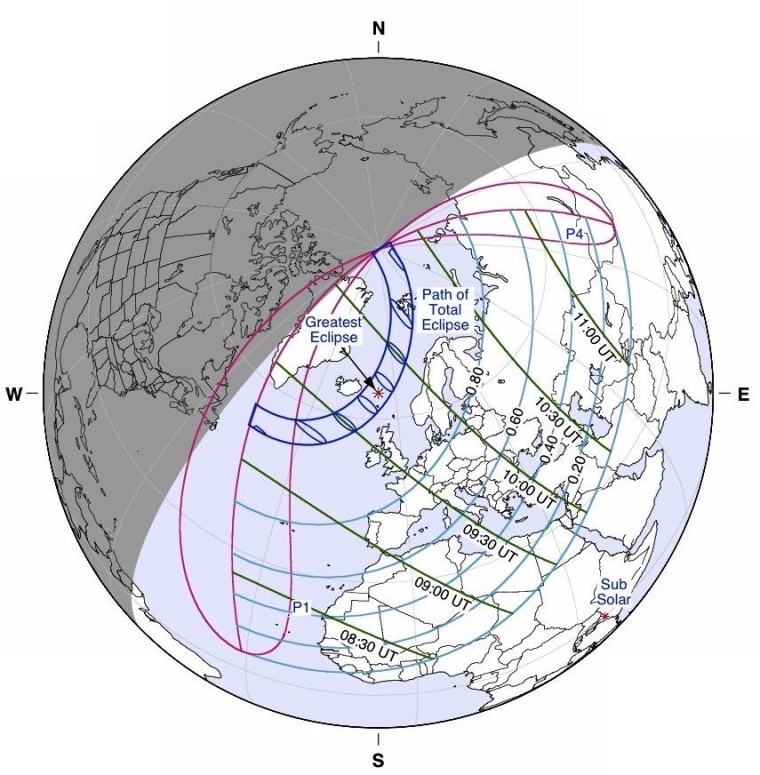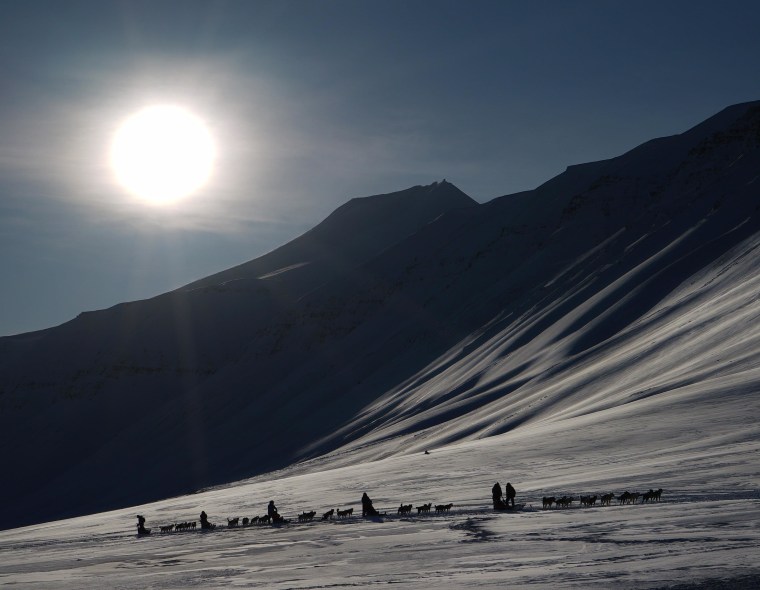Thousands have flocked to some of the most remote places on Earth to see a total solar eclipse on Friday, and millions more will be in a position to watch the moon take a bite out of the sun — with proper eye protection, of course. But to see it live from the United States, you'll have to get up before the crack of dawn and turn on your computer or TV.
The eclipse is perfectly placed if you're north of Scotland in the Faroe Islands, or north of Scandinavia in Norway's Svalbard Archipelago. Those are the most significant bits of land that lie in the path of totality, and hard-core eclipse-chasers booked their accommodations months ago.
"This is our 10th total eclipse," Les Anderson, a 60-year-old from San Diego, told The Associated Press in the Faroe capital city of Torshavn. "We love to watch them and being able to look at the corona with your eyes in the middle of the eclipse is really an exciting moment, to experience the diamond rings coming and going."
The weather outlook is touch-and-go in the Faroes, but more promising in Svalbard. The folks at a Spanish-based ballooning company, Zero2Infinity, is taking a different tack. They plan to send a camera-equipped balloon high above the clouds to capture a 360-degree video view.
Bear Attacks Tourist in Solar Eclipse Hot Spot
Watching the skies
If the skies are clear, the eclipse's partial phase should be visible from Greenland and Iceland, plus wide swaths of Europe, northern Asia and Africa. Eclipse glasses are being sold at "rip-off prices," according to Britain's Daily Mirror.
Gazing at the sun can do permanent eye damage, so it's important to take precautions — either by looking through solar filters (even at rip-off prices) or using a pinhole projector. This guide from NASA lays out the options.
Solar eclipses occur when the moon passes directly over the sun, as seen from Earth. The show gets started around 7:41 GMT (3:41 a.m. ET) when the moon's shadow touches down in the North Atlantic, and hits prime time at 9:45 GMT (5:45 a.m. ET) when the eclipse's total phase reaches maximum. The shadow skitters off the face of the Earth in the Arctic around 11:50 GMT (7:50 a.m. ET).
The two-minute dose of totality begins at 9:41 GMT (5:41 a.m. ET) in the Faroe Islands, and hits Svalbard at 10:11 GMT (6:11 a.m. ET). To get all the viewing circumstances for specific locations, check in with TimeandDate.com.

Flash Interactive: The Science of a Solar Eclipse
Watching the screen
This eclipse is notable for astronomy fans not only because the track of totality swings through an exotic corner of the world, but also because it's a "Supermoon Spring Eclipse." The event occurs close to the time of the seasonal equinox, and at a time when the moon is near the closest point in its orbit around Earth.
But if you're an American, you have to be an early riser sitting in front of a display screen to get in on the action: The eclipse will be over by the time the sun comes up.
The Slooh virtual observatory has set up a streaming-video operation in the Faroe Islands to take in the scene, for a webcast due to begin at 4:30 a.m. ET. There'll be commentary from solar researchers and Slooh correspondents. The stream will be available via Slooh.com, and Twitter users can ask questions in real time using the hashtag #SloohEclipse.
The Italy-based Virtual Telescope Project 2.0 will provide live views of the partial eclipse starting at 4:15 a.m. ET. You can bet there'll also be live coverage from European TV outlets, and NBC News plans to webcast coverage as well. (Watch this space for the link.)

Demons Eat the Sun: Solar Eclipse Myths Explained
After the eclipse, we'll have a recap of the action plus pictures from the eclipse zone. Want to call attention to your favorite shots? Use the hashtag #NBCEclipse on Twitter or Instagram, or post pictures to the NBC News Science Facebook page. And start making your plans for America's solar eclipse on Aug. 21, 2017.